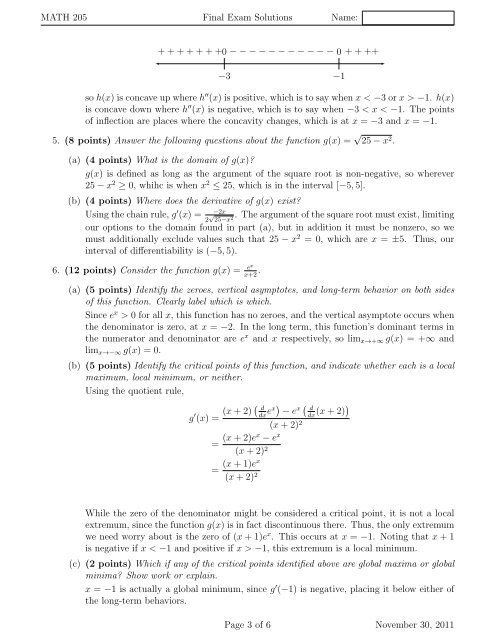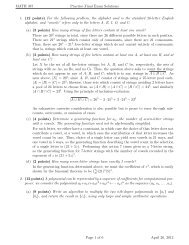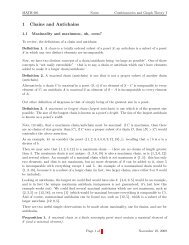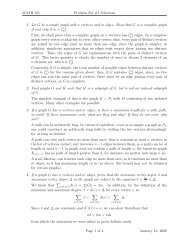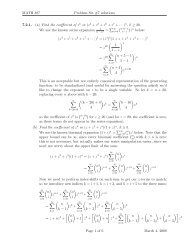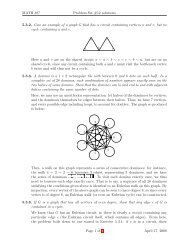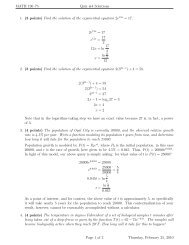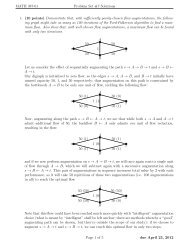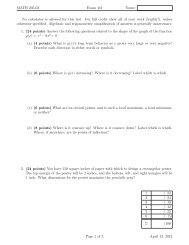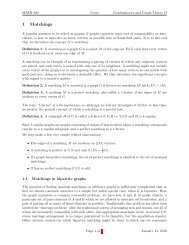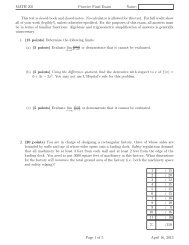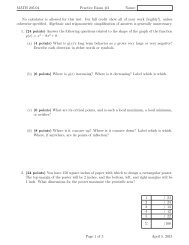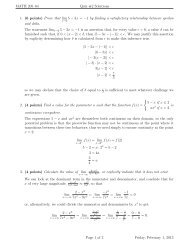MATH 205 Final Exam Solutions Name: 1. (12 points) The keratoid ...
MATH 205 Final Exam Solutions Name: 1. (12 points) The keratoid ...
MATH 205 Final Exam Solutions Name: 1. (12 points) The keratoid ...
You also want an ePaper? Increase the reach of your titles
YUMPU automatically turns print PDFs into web optimized ePapers that Google loves.
<strong>MATH</strong> <strong>205</strong> <strong>Final</strong> <strong>Exam</strong> <strong>Solutions</strong> <strong>Name</strong>:<br />
+ + + + + + + 0 − − − − − − − − − − − 0 + + ++<br />
−3<br />
−1<br />
so h(x) is concave up where h ′′ (x) is positive, which is to say when x < −3 or x > −<strong>1.</strong> h(x)<br />
is concave down where h ′′ (x) is negative, which is to say when −3 < x < −<strong>1.</strong> <strong>The</strong> <strong>points</strong><br />
of inflection are places where the concavity changes, which is at x = −3 and x = −<strong>1.</strong><br />
5. (8 <strong>points</strong>) Answer the following questions about the function g(x) = √ 25 − x 2 .<br />
(a) (4 <strong>points</strong>) What is the domain of g(x)?<br />
g(x) is defined as long as the argument of the square root is non-negative, so wherever<br />
25 − x 2 ≥ 0, whihc is when x 2 ≤ 25, which is in the interval [−5, 5].<br />
(b) (4 <strong>points</strong>) Where does the derivative of g(x) exist?<br />
Using the chain rule, g ′ (x) =<br />
−2x<br />
2 √ . <strong>The</strong> argument of the square root must exist, limiting<br />
25−x 2<br />
our options to the domain found in part (a), but in addition it must be nonzero, so we<br />
must additionally exclude values such that 25 − x 2 = 0, which are x = ±5. Thus, our<br />
interval of differentiability is (−5, 5).<br />
6. (<strong>12</strong> <strong>points</strong>) Consider the function g(x) = ex<br />
x+2 .<br />
(a) (5 <strong>points</strong>) Identify the zeroes, vertical asymptotes, and long-term behavior on both sides<br />
of this function. Clearly label which is which.<br />
Since e x > 0 for all x, this function has no zeroes, and the vertical asymptote occurs when<br />
the denominator is zero, at x = −2. In the long term, this function’s dominant terms in<br />
the numerator and denominator are e x and x respectively, so lim x→+∞ g(x) = +∞ and<br />
lim x→−∞ g(x) = 0.<br />
(b) (5 <strong>points</strong>) Identify the critical <strong>points</strong> of this function, and indicate whether each is a local<br />
maximum, local minimum, or neither.<br />
Using the quotient rule,<br />
g ′ (x) = (x + 2) ( d<br />
ex) − e ( x d<br />
(x + 2))<br />
dx dx<br />
(x + 2) 2<br />
= (x + 2)ex − e x<br />
(x + 2) 2<br />
(x + 1)ex<br />
=<br />
(x + 2) 2<br />
While the zero of the denominator might be considered a critical point, it is not a local<br />
extremum, since the function g(x) is in fact discontinuous there. Thus, the only extremum<br />
we need worry about is the zero of (x + 1)e x . This occurs at x = −<strong>1.</strong> Noting that x + 1<br />
is negative if x < −1 and positive if x > −1, this extremum is a local minimum.<br />
(c) (2 <strong>points</strong>) Which if any of the critical <strong>points</strong> identified above are global maxima or global<br />
minima? Show work or explain.<br />
x = −1 is actually a global minimum, since g ′ (−1) is negative, placing it below either of<br />
the long-term behaviors.<br />
Page 3 of 6 November 30, 2011


